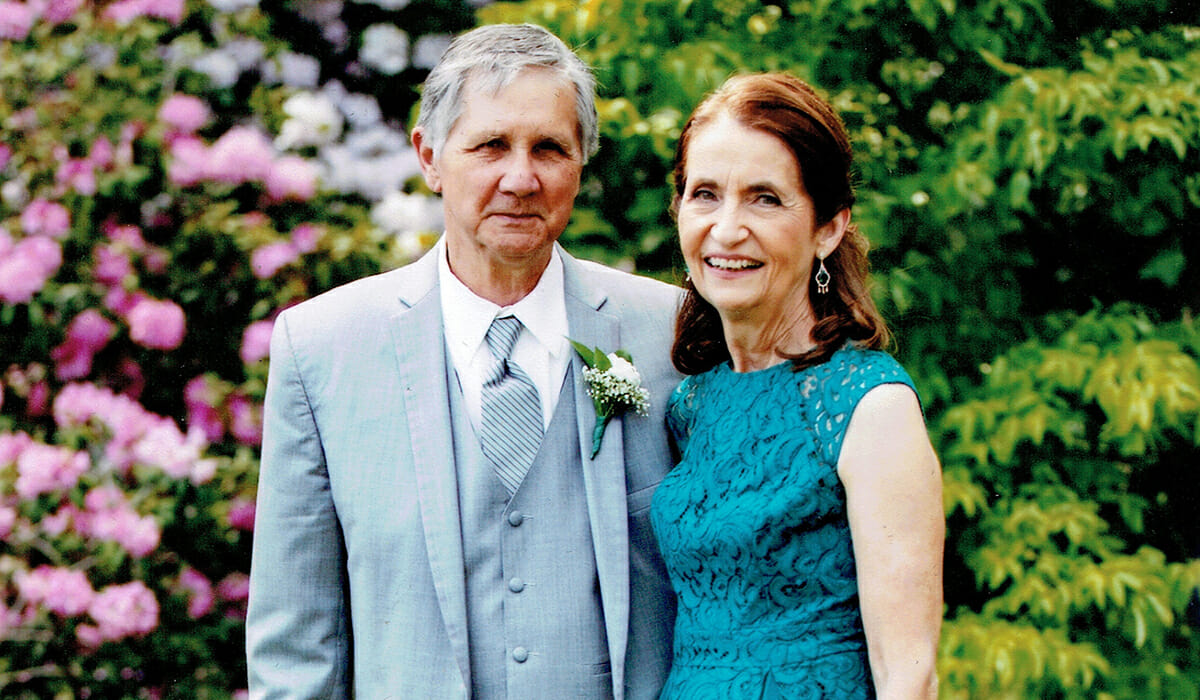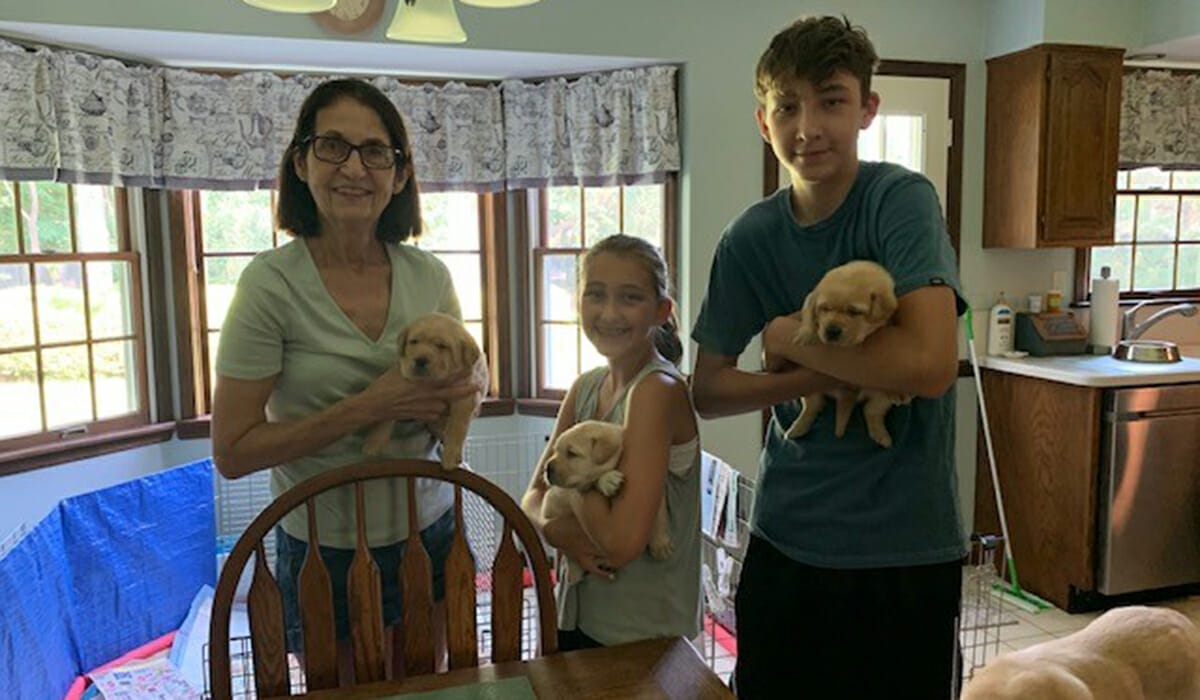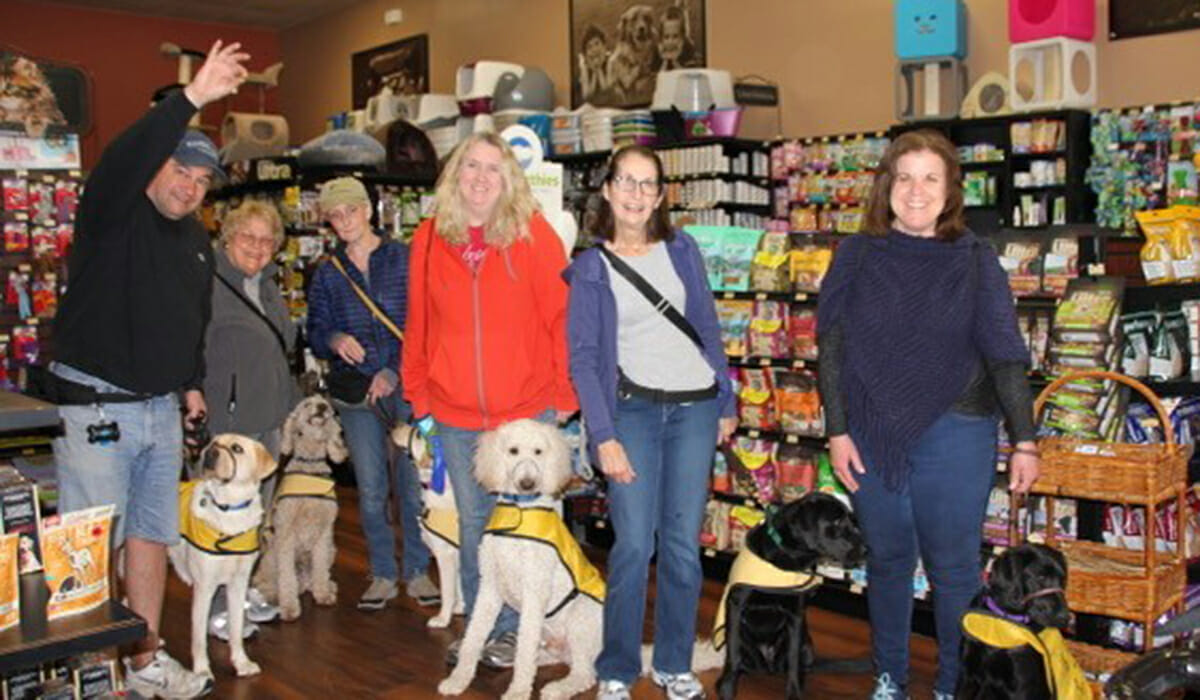Couple Dedicates 40 Years to Helping Train Guide Dogs

Meet Daily Point of Light Award honorees Doreen and Phil Zipf. Read their story and nominate an outstanding volunteer or family as a Point of Light.
Forty years ago, husband and wife Doreen and Phil Zipf noticed an ad in the local paper looking for volunteers to help the Guide Dog Foundation in Smithtown, N.Y. Doreen was raised to be a volunteer, and Phil had an admiration for guide dogs since he was a kid and read a short story about how the animals helped the blind. Along with the fact that they had recently moved only a short distance from the Foundation, it seemed like a no-brainer to sign up.
Now four decades later, Doreen and Phil’s volunteerism is still going strong. The duo have raised 13 puppies and taken care of several of the Foundation’s breeders. Doreen also helps teach orientations for other volunteers and sews coats to signify the guide dogs who are in training, while Phil helps “taxi” dogs to vet appointments and to the airport when they need to travel. The couple passed on the spirit of volunteerism to their four children, who helped with the dogs while growing up, and one of whom became a breeder caretaker. Doreen and Phil currently have four dogs from the Foundation in their home — two retired breeders, a breeder still having puppies that will hopefully grow up to be guide dogs, and a “release” dog who didn’t make it through training. While their house is full at the moment, they aren’t opposed to taking on puppies in the future, and have no sights on discontinuing their service anytime soon.
Describe your volunteer role with the Guide Dog Foundation.
Doreen: We have been volunteering there for 40 years. When we first started volunteering, we started off as puppy raisers. … We raised another one, and another one, and we did that for probably the first 10 years. [Then] we got into being caretakers [for breeders]. That was ’91. In between, there were other puppies. We actually helped buy a couple puppies for the breeding program. … We’ve had at least eight litters the house. I just sent my last one back last Friday. There were three little labs, so now they’re back at their Foundation and they will get all their shots and their examinations. They will go out to puppy-raising homes and they will be raised, and they will come back for training.
Of course since coronavirus, we haven’t done it since March, but I go up one day a week and work with the little puppies in the nursery when they’re four to six weeks — holding them, letting them walk a little bit on the lead, depending on the age. Then [we do] other little projects along the way. We’ve been around a long time, and we know everybody. Sometimes we’ll get a call, “Hey, do you want to come do this?” and I’ll go up and do it. … We’ve taken temp dogs sometimes, just dogs who need temporary homes maybe for a week or two.

Can you discuss the additional volunteer work you do with the foundation individually?
Doreen: The puppies being raised, they have these little jackets they wear to identify them so they can walk into a store. In New York, they do not have access rights for puppies. Obviously a guide dog has access rights, but in New York state they don’t have access rights for dogs you are training yourself, like the puppy raisers. It’s very important that they go out and be socialized, so they get this little jacket that identifies them as from the Guide Dog Foundation. There’s no problem at all. Nobody says you can’t bring the dog in here. I got involved with that and I am now the lead sewer. I cut all the coats for the last 12 years, I think. Now I’ve gotten to the point where we put them in kits. I cut the binding and straps, I actually make the straps, put them in kits, and then they go out to people who sew them.
I also do orientations for temporary homes and breeder caretakers. I used to do them at the Foundation, but with coronavirus, I now do them on Zoom, which is always interesting. I explain to people what a temporary home is, what’s expected of you. If it’s short term, we take the dog for two weeks in the summer to get them out of the kennel. Some of them were release dogs [who didn’t meet the qualifications to become guide dogs] and they were waiting to be adopted. Then others were actually training dogs but they’re waiting for students to come, so sometimes there’s a gap in time between the two processes, and they like to get them out into a home. … Of course, a breeder caretaker is the other thing we’ve done. Basically, I explain to people what the responsibility of that is. It’s not your dog, the dog belongs to the Foundation, but you take care of the dog … and keep the dog’s manners up when they’re in public. They have to behave because they’re a representative to the Foundation. Those are the two classes I give for them.
Phil: I used to take dogs to LaGuardia and MacArthur airport for transport, where they would fly different places in the country. Sometimes I would go to LaGuardia to pick them up. Later on, I would take them mostly to local vets and things like that.
What has been the most rewarding part of your volunteer work?
Phil: When I was a kid in grade school, I read a short story called ‘My Eyes Have a Cold Nose’ [by Hector Chevigny]. It was amazing to read about this man who got a guide dog and could simply cross the street safely. That always impressed me. When we moved out here in 1978, shortly thereafter, like the beginning of 1980, we saw the Foundation was right around the corner from us. I said, “Oh, it would be nice to get involved in that someday.” Then my wife saw an ad in the paper that they were looking for puppy raisers, or they called them puppy walkers at that time. They gave us this black female Labrador. Her name was Ace and she was sponsored by the Long Island Railroad. She didn’t become a guide dog, but she did after a certain amount of time become a detector dog for the Connecticut State Police Department. She became what’s popularly known now as a service dog. I find it very rewarding. People always ask you a million times, “Oh, don’t you find it hard to give them up?” I always counter with, “I’m not doing this to raise a dog for myself. I have my own dogs. I’m doing this to try to help somebody else.”
Since you started volunteering, have you consistently always had a dog in the house?
Doreen: I would say yes. Right now we have four of them. There’s an active breeder, two retired breeders, and one release dog. All together, we’ve raised 13 puppies. … We’ve pretty much always had one of their dogs in the house since 1980. I think there was a break when we lost our own dog. Now all the dogs are theirs, but when we started this, we had our own dog. To me, that’s important, because if you’re going to raise a puppy and that’s the only puppy in the house, when you give it back, it can be a little emotional. You have a different sense when you have your own dog in the house and you know this dog is staying and you raised it, especially when children are concerned. … So we always had our own dog. That was the only break. That was back in the 80s. Didn’t last long. I’ve had as many as even two puppies in the house for a very short time.
How does it feel knowing your children have followed in your footsteps with volunteering?
Doreen: Very good. It was kind of in the back of my mind, going way back then, [that] it was important to show them that you should give back. That was a real way of giving back, and it was something they could enjoy. They knew they had to give the dog up. This wasn’t a dog they were going to keep. They would go to the graduation, and you would see the person get the dog. As I said, of the 13 [puppies], there was only one that didn’t make it. One became a police dog, and four of them actually became breeders. … They were dogs that would have been guide dogs, but they chose them to instead be the mothers of future generations. I felt that as a parent, that was an important thing to teach the children.

What would you want people to know about this type of volunteer work?
Phil: It’s a demanding but very satisfying adventure. That’s what it is. It’s not a Monday, Wednesday, and Friday deal. … It’s a 24-hour deal. You have to get up. You have to take them out,. You have to feed them. You have to walk them and take care of them. But it’s very, very rewarding, and there’s groups up there that help you with the training and the obedience and the socialization. For me, it was and still is very rewarding.
Why is it important for people to volunteer?
Phil: If they can — and not everybody can due to time constraints, or even money — it’s a good thing to give back to the community. I felt that this was a good way to give back. I always said it’s very satisfying to see a dog you raised, from a puppy to about a year or fourteen months, help somebody cross the street safely.
What do you want people to learn from your story?
Doreen: When you get involved — and I’ve been involved in other volunteer jobs, too — it’s really a very rewarding thing when you give to someone else. It’s very rewarding to see that you helped someone. Everybody [at the Foundation] helps. They help along the way. When you raise a puppy, you’re helping along the way. There’s other people who are going to do other things raising that dog. I think it’s a very rewarding experience. I think sometimes people get caught up, not to criticize, but they get caught up in what’s the best movie, and caught up in Twitter and cell phones. To have a litter in the house and watch them go from the size of little mice when they’re born — and there’s only three in the litter who walked out of here, and the biggest one was 12.5 pounds when they walked out of here. For five and a half weeks, it’s an amazing thing to watch and be a part of and know now they’re going to go to someone else. They’ll go through the program and be raised that certain way, and hopefully they’ll come back and help someone. You’re part of a group and everyone gives. … You’re doing it for the end result, and you’re a part of that end result.
Do you want to make a difference in your community like Doreen and Phil? Find local volunteer opportunities.
